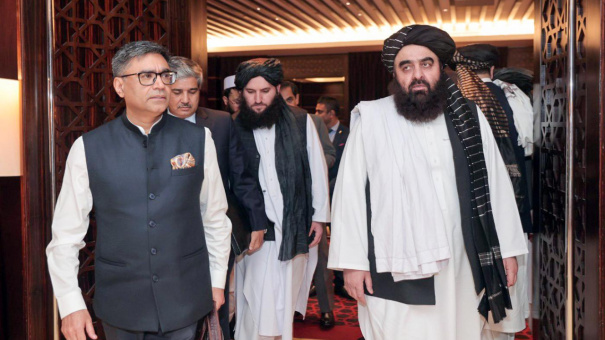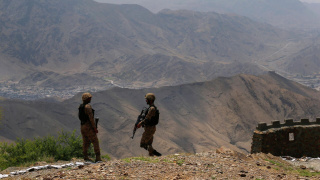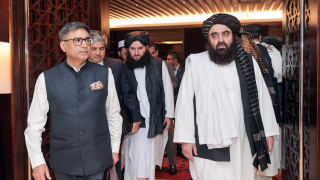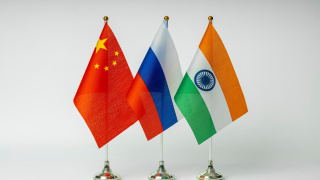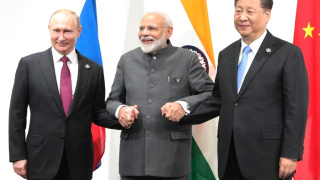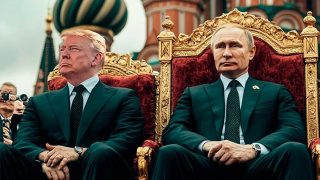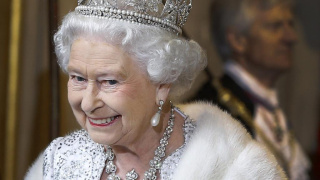India welcomes Afghan foreign minister to New Delhi–expands foot print in Eurasia
The visit to India by Afghanistan’s acting foreign minister, Amir Khan Muttaqi, has been a pivotal event that will add to the geopolitical contestations in South Asia and Eurasia.
With Muttaqi’s visit, India is now on the frontline to impart geopolitical and geoeconomic heft to the region, along with key other players in the fray, especially Russia, China, Pakistan, and the United States.
To gauge the importance of the visit, it may be necessary to rewind to 2021. On August 15 of the that year, the Afghan Taliban re-occupied Kabul, which had fallen to the Americans and its allies in 2001. The Americans occupied centre-stage in Kabul, after the suicide passenger aircraft smashed and destroyed the twin-towers in New York in 2001. The 9/11 targeting, ostensibly by Osma Bin Laden’s Al Qaeda network triggered the Global War on Terror (GWOT). Afghanistan, where Bin Laden and his network had trained under the patronage of Taliban’s patriarch Mullah Omar, became the epicentre of GWOT, to which Iraq was later added. Following US attacks in Afghanistan, Taliban 1.0 was quickly defeated and dispersed.
Over the years in exile, Taliban, with a large following among ethnic Pashtuns that live on either side of the Durand line—the alignment that separated Afghanistan from Pakistan—evolved into a much stronger nationalist force. It is currently focusing on nation-building, discarding its earlier position as the launch pad for global Jihad.
The Taliban 2.0 that has reemerged and assumed power in Kabul after defeating the western backed government of President Ashraf Ghani in August 2021, has also demonstrated that it had completely overhauled is foreign policy. Pakistan, its patron- in- chief during the Taliban 1.0 phase when the group first assumed power in 1996, is now a hostile neighbour. The Taliban 2.0 has refused to hand over Afghan kingpins who are wanted by Pakistan, and have been accused of marshalling terror attacks. Islamabad has also blamed Afghanistan of sheltering the Tehreek-e-Taliban (TTP), which has targeted Pakistani forces, especially in North Waziristan and South Waziristan—two restive districts of Pakistan’s Khyber Pakhtunkhwa province across the infamous Durand Line.
In December 2024, the Pakistani military had launched air strikes in Afghanistan’s Paktika province, which borders South Waziristan. While Pakistan said it had targeted sites where TTP fighters had sought refuge, the Taliban government said that 46 civilians in Afghanistan were killed in the air strikes.
This year, Pakistan also ramped up the deportation of Afghan refugees, further stressing ties. Early this year, Pakistan said it wants three million Afghans to leave the country.
After the exit of the US forces, apart from Pakistan, Taliban 2.0 has also become Washington’s arch-foe.
However, the exit of the US forces, and Pakistan’s internal woes activated other regional heavyweights which moved in strongly to fill the resulting power vacuum, following Washington’s exit.
The Russians, which have not forgotten their own humiliation when they had to lose face by vacating their forces from Afghanistan at the end of the so-called anti-Soviet Jihad, came in impactfully to bond with Taliban 2.0, once the Americans chaotically departed.
On July 3 this year, Russia became the first country to formally recognise the Taliban government in Afghanistan. Russia’s Foreign Ministry, made the announcement, confirming that the Taliban flag will now fly over the Afghan embassy in Moscow. Russian President Vladimir Putin approved the decision following a proposal from Foreign Minister Sergey Lavrov. Russia’s ambassador to Afghanistan, Dmitry Zhirnov, stressed that the move reflected Russia’s intent to establish a full-fledged partnership with Afghanistan. In turn Taliban Foreign Minister Amir Khan Muttaqi welcomed the decision, calling it a “brave example” for other countries to follow.
The Chinese too have been hyper-active to engage with the Taliban after the unsavoury exit of US forced from Afghanistan.
There at least three hyper-important reasons that explain Beijing’s activism in the heart of the Hindukush mountains.
First, Afghanistan is one of the battlegrounds across the globe where the Chinese and the Americans have been contesting for influence. Afghanistan’s unique geography, makes it a natural ground zero of the great game among rival powers as witnessed by Russians and the British during the colonial era. The Chinese and the Americans are fully sensitised to the fact that Afghanistan is the gateway to Central Asia, China, West Asia, and South Asia. Consequently, if either of them can exercise strong geopolitical influence in Kabul, they will be able to project power in four different geographies. The same logic also holds true for other aspirational nations including Russia and India.
Second, there are clear geoeconomic reasons for China to seek a deeper connect with Afghanistan. It is estimated that Afghanistan possesses some 2.3 billion metric tons of iron ore and 1.4 million metric tons of rare-earth minerals. The US Geological Survey has fathomed that the country sits on untapped minerals, such as iron, gold, and lithium worth $1trillion.
In July last, Chinese engineers and the Taliban government officially started work at Mes Aynak to tap the world’s second largest deposit of copper.
It is estimated that the area sits on 11.5 million tons of copper ore—a key metal to power electric vehicles, renewable energy, and data centres.
Third, Afghanistan presents a potential plan-B, in case, the much-spotlighted China Pakistan Economic Corridor (CPEC), a flagship of China’s Belt and Road, somehow fails to take off. China has hugely invested in CPEC—which runs from Gwadar to Kashgar in China’s Xinjiang Autonomous Region (XAR)-- mainly because it gives it valuable access to the Arabian Sea.
But, in case the Baloch insurgency or American presence in Balochistan, through which the Pakistan leg of CPEC runs, impedes the full development of the corridor, Afghanistan can present an alternative solution. More specifically, at the northeastern end, Afghanistan connects with China through the Wakhan corridor. The 500-kilometre high-altitude passage opens out into XAR. Unsurprisingly, the Chinese have already shown intent to build a road, and possible a railway through Wakhan. At the other end, Afghanistan can connect to Iranian port of Chabahar. Afghanistan circular ring road already loops through Herat, the Afghan city that borders Iran. From an India built road can connect with Chabahar, a deep-water port, which is the terminus of this route. Consequently, China can develop an alternative to CPEC by leveraging the geography of the Iran and Afghanistan, provided India also cooperates—something that is possible given the rapidly plummeting relations between New Delhi and US.
China’s drive to develop deep water ports is also part of its geopolitical contest with the United States in the maritime domain. Not only the Arabian Sea, China has developed the deep-water port in in the Bay of Bengal—at Kyaukphyu in Myanmar’s Rakhine state, from where oil and gas pipelines already connect to China’s Yunnan province. By building a string of ports in the Indian Ocean, China wants to minimise its dependence on the Malacca straits—a US dominated channel that connects the Indian and the Pacific oceans.
Following the exit of US forces, the Americans have mounted a feverish effort to claw back into the southwest Asia/ Eurasia Zone. The comeback process began during the Biden administration, but has picked up pace after the arrival of Donald Trump as the 47 th President of the United States.
To stage a return in the region, the Americans have gone back to their default position—of reviving their relationship with Pakistan; a country that borders India, Afghanistan, China, and Iran.
Not surprisingly, the Trump administration has targeted the Pakistan military—the real custodian of power in Islamabad. In a rare gesture, Trump invited for lunch Pakistan’s military boss, Field Marshall Asim Munir. Munir and Pakistani Prime Minister Shehbaz Sharif later jointly met Trump when the two had visited the United States to participate in the United Nations General Assembly (UNGA) session last month.
The meetings apparently went well, also because Pakistan had diligently massaged Trump’s ego by proposing his name for a Nobel Peace Prize for his alleged contribution for ending the latest round of fighting between India and Pakistan. India, in turn had rejected the notion that Trump’s intervention had led to the ceasefire by insisting that that Pakistan sued for peace because of India’s military pressure.
Earlier, in August 2025, the US and Pakistan held a bilateral Counterterrorism Dialogue in Islamabad, signalling a revival of partnership after years of frictional relations. Besides, the US designated the Balochistan Liberation Army (BLA) and Tehrik-e-Taliban Pakistan (TTP)—both in Pakistan’s crosshairs as foreign terrorist organizations.
Recent media reports also suggest that Pakistan is offering its port of Pasni on the Arabian Sea for usage by the Americans—an offer that is bound to offend the Chinese, as Gwadar, the port they have developed is a short distance away.
In a statement that has little value without Pakistan’s active involvement, Trump has also recently jolted the region by announcing that US wants to back at the Bagram Air Base in Afghanistan.
Trump proposed the idea during a press conference with British Prime Minister Keir Starmer.
Significantly, Trump repeated his view that a US presence at Bagram is of value because of its proximity to China.
“But one of the reasons we want that base is, as you know, it’s an hour away from where China makes its nuclear weapons,” Trump said. “So, a lot of things are happening.”
With the US backing Pakistan, India’s arch, it is only natural that the India will seek to bond with Afghanistan as a counterweight.
It is therefore not surprising that the India welcomed Muttaqi with open hours, quickly announcing a string of measure to upgrade ties with Kabul.
First, Indian foreign minister, S. Jaishankar during a meeting with Muttaqi announced that India was upgrading its technical office in Kabul to a full-fledged embassy. Second, India was opening a freight air corridor with Afghanistan to expand trade. Third, the decks have been cleared for India’s investments in Afghanistan’s lucrative mining sector. Fourth, India was reviving all its high-impact humanitarian projects that were stalled because of political turbulence and change of guard in Kabul.
While the list of engagements is impressive, it may be misleading to view it in a bilateral framework alone. On the contrary, the India’s outreach docks with a slew of initiatives towards Afghanistan that Russia and China have undertaken. In fact, it opens fresh opportunities for new bilaterals as well as Russia-India-China dialogue to strengthen the troika’s geopolitical, geo-economic and geo-cultural heft in a region that has thousands of years of shared history.
With key members of the Trump administration threatening to “fix” India after the Modi administration refused to fall in line to Washington’s diktat of ending its energy relationship with Russia, or of opening up its politically sensitive farm sector to US exports, it may be appropriate for India to pivot towards Eurasia from the Indo-Pacific, as only principled defiance and not subservience may lead to a new round of engagement with the US on a later date. In other words, the road to Washington may now have to pass through Beijing and Moscow as any sign of weakness may only encourage the US to bulldoze India.
